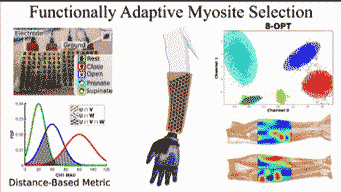Control strategies for upper limb myoelectric prostheses have become increasingly sophisticated over the years. Modern techniques depend on consistent and distinguishable surface electromyogram (sEMG) signal patterns produced by the residual limb musculature. These patterns are mapped to the terminal device movements. Electrode placement has an enormous impact on the quality and characteristics of sEMG signals acquired. In clinical settings, the locations for targeted electrode placements (or myosites) are currently identified by the clinician through palpation of the residual limb while the patient performs repeated motions. This process is subject to the clinician’s skills and dependent on physical movement of the muscle groups corresponding to high muscle activity during contraction.
Current methods are subjective, time-consuming, or increasingly burdensome on clinicians as channels increase and classification algorithms become more complex. There is a need for a tool to help clinicians locate optimal electrode configurations accurately to minimize fitting time without compromising performance. Previous site selection methods have only been evaluated using LDA the increasingly popular ANN-based classifiers. Further, they do not offer any insight into expected performance per electrode count without training and testing a classifier.
In this paper, we present the FAMS myosite selection system, a technique for efficiently determining the quantity and location of electrodes that should be added to a prosthesis socket to achieve a target fidelity for differentiating between some desired set of movement classes. We use a class separability metric to minimize the number of myosites required to exploit the full potential of existing musculature for pattern recognition control. We also evaluate the suitability of our metric as a means to rapidly approximate classification accuracy. This additionally allows clinicians to determine the appropriate trade-off between classifier performance and electrode count for each individual patient, dependent on the motion classes they are interested in utilizing.

